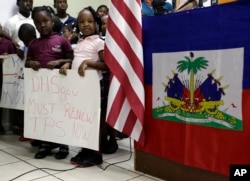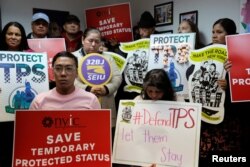Over the next 18 months, roughly 310,000 people in the United States may lose their ability to live and work legally in the country, as the Trump administration ends the humanitarian Temporary Protected Status program for several nations that have seen the effects of armed conflict and natural disasters improve in the last year, according to federal officials.
But those same officials aren't sure where those TPS beneficiaries will end up once their status expires. An unprecedented number of people will lose their legal privilege to remain in the country within a relatively short timeframe.
Neither government officials nor lawyers nor activists have a good understanding of what's about to happen. And U.S. Citizenship and Immigration Services (USCIS), the federal agency that oversees the TPS program, said it does not track the outcomes of former TPS recipients, so it can't extrapolate.
TPS is a non-immigrant status, which means that those who receive it are not on a pathway to permanent residency or citizenship — they are, as the name states, in a temporary holding pattern triggered by a crisis in their home country.
Royce Bernstein Murray, policy director at the American Immigration Council, notes that when paired with the potential extinction of the Deferred Action for Childhood Arrivals (DACA) policy — ended by Trump in 2017 and now ensnared in the judicial system — there are potentially a million currently legal foreign-born people in the U.S. who will lose their protected status.
And for a government that cites "national security" as its rationale for immigration restriction policies — humanitarian or otherwise — officials could lose track of those million or so people.
"Who gains when we take away people's ability to come forward and be forthright about who they are and where they are?" Bernstein Murray said.
"Many of us have long argued that it's better for everyone — the immigrants themselves and society at large — for people to have a way to come forward, to be vetted, to provide their information, so we know who's here. No need to wonder where populations are and whether they pose a safety risk," she added.
Writing for the immigration-restrictionist Center for Immigration Studies, David North noted that two of the highest source countries for TPS beneficiaries — El Salvador and Honduras — had fewer recipients in 2014 and 2015. They dropped 29 percent and 42 percent, respectively, compared with the peak re-registration numbers in 2001 and 2003.
What could account for those differences? The same outcomes the U.S. may see in the coming 18 months, as TPS expires: adjusting to a different immigration or non-immigrant status, moving to another country, going back to their home country, dying or becoming undocumented.
Options for TPS recipients
There isn't much — if any — data about what happens to TPS recipients once their status expires or is canceled. Even if there were, the next 18 months will be unprecedented in the volume of recipients who lose legal status.
Barring a dramatic change from Congress or the Trump administration, there are limited options for TPS recipients who are going to lose their status.
Some TPS recipients may go home. Of course, this was the intent of TPS — to wait until the countries were stable and able to welcome their expatriate nationals back. But it is unclear how many TPS recipients do, in fact, return once their status expires. There are some cases from the 1990s and early 2000s of countries for which TPS was terminated, but again, USCIS said it does not "actively track" former TPS beneficiaries. Former recipients could, in theory, also move to a third country.
However, nationals from some countries have been in the U.S. for decades. They've raised families, kept jobs and built self-sufficient lives. For about 2,100 TPS recipients, largely from El Salvador (92.3 percent) but also Honduras (7.5 percent) and Nicaragua (0.2 percent), the CIS study found high levels of labor force participation — 94 percent among men and 82 percent of women.
About 1 in 3 own their homes, and 4 in 5 pay income tax, according to the data from the Center for Migration Research.
"TPS holders' in-between legal status is reflected in their in-between conditions, as they generally do better than undocumented immigrants on the various indicators discussed in this report but not as well as those immigrants who are authorized or perhaps naturalized, or the U.S. population in general. As such, TPS represents a step in the right direction," according to the report.
TPS recipients may also:
* Revert to their original status — for example, if they came on a student visa, got TPS, and are still a student;
* Stay illegally and risk deportation if they are caught or detained;
* Adjust to a different status — through marriage, work, family or asylum.
In some cases in the 1990s, Congress acted to provide for a permanent status for nationals from some countries. However, momentum for such action does not appear to be building for residents about to lose their legal status.
The Trump administration terminated TPS for six countries in 2017 and 2018, extended it for two others, and will make decisions about two more this year.









